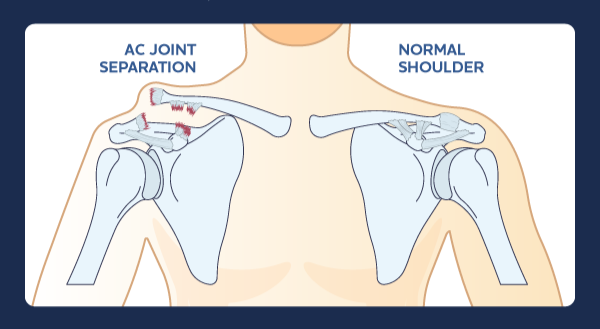
AC Joint Injury and Shoulder Separation Treatment In San Antonio
What is an AC Joint Injury or Shoulder Separation?
An Acromioclavicular (AC) joint injury, commonly known as a shoulder separation, occurs when the ligaments connecting the collarbone (clavicle) to the shoulder blade (acromion) are damaged or torn. This injury can lead to instability and pain in the shoulder, affecting both mobility and strength. AC joint injuries are common in athletes and individuals involved in high-impact or overhead activities.
Dr. Jeremy Rush, a dual-fellowship trained orthopedic surgeon specializing in sports medicine and pediatric orthopedics, has extensive experience in diagnosing and treating AC joint injuries. Whether you’re an athlete or an active individual in San Antonio, Dr. Rush offers personalized care to get you back to full strength.
Types of AC Joint Injuries
AC joint injuries are classified into grades based on the severity of ligament damage:
Grade 1: Mild sprain of the AC ligament, with no displacement of the collarbone.
Grade 2: Partial tear of the AC ligament, causing slight displacement of the clavicle.
Grade 3: Complete tear of the AC and coracoclavicular (CC) ligaments, leading to significant displacement of the clavicle.
Grade 4-6: More severe injuries with displacement of the clavicle in various directions, often requiring surgical intervention.
Common Causes of AC Joint Injuries
AC joint injuries often occur from direct trauma to the shoulder, such as:
Sports injuries: High-contact sports like football, hockey, or rugby frequently cause AC joint injuries due to tackles, falls, or collisions.
Falls: Landing directly on the shoulder after a fall, such as from a bike or during skiing, can injure the AC joint.
Repetitive overhead motion: Overhead activities, such as weightlifting or throwing sports, can place stress on the AC joint over time.
Symptoms of an AC Joint Injury
An AC joint injury or shoulder separation typically presents with the following symptoms:
Shoulder pain: Especially at the top of the shoulder, which may worsen with movement.
Swelling and bruising around the shoulder joint.
Visible deformity: A bump on the top of the shoulder, where the clavicle is displaced.
Weakness in the shoulder, making it difficult to lift or move the arm.
Limited range of motion: Difficulty with overhead movements or lifting objects.
If you suspect an AC joint injury, seeking medical attention promptly can ensure proper diagnosis and treatment.
Non-Surgical Treatment Options for AC Joint Injuries
-
Rest and Immobilization
A sling may be used to keep the shoulder stable and reduce pain during the initial healing period.
-
Icing and Anti-Inflammatory Medications
To reduce pain and swelling in the injured shoulder.
-
Physical Therapy
After the initial healing period, physical therapy can help restore strength, flexibility, and range of motion in the shoulder.
-
Corticosteroid Injections
For cases of persistent pain or inflammation, a corticosteroid injection may be recommended to relieve symptoms.
Surgical Treatment Options for AC Joint Injuries
-
AC Joint Reconstruction
Using surgical techniques to repair or reconstruct the damaged ligaments, restoring stability to the joint.
-
Arthroscopic Surgery
Minimally invasive procedures may be used to repair the joint and surrounding tissues with smaller incisions and faster recovery times.
Returning to Sports After an AC Joint Injury
The recovery process after an AC joint injury can vary depending on the severity of the injury and the treatment required:
Initial Healing (2-6 Weeks): During the early stages of recovery, the shoulder may be immobilized, and activity is limited to allow the ligaments to heal.
Physical Therapy (6-12 Weeks): Physical therapy is essential for regaining strength and flexibility in the shoulder, focusing on range of motion and stability.
Return to Sports (3-6 Months): Most athletes can return to their sport within 3-6 months, depending on the type of sport and the extent of the injury. Contact sports may require a longer recovery period to ensure the shoulder is fully stabilized.
FAQs about AC Joint Injuries
-
Dr. Rush will perform a physical exam to assess the severity of the injury and may order X-rays or an MRI to confirm the diagnosis and evaluate any ligament damage.
-
Recovery times vary depending on the grade of the injury. Mild injuries (Grade 1-2) may heal in 2-6 weeks, while more severe injuries (Grade 3 and higher) may require several months of rehabilitation.
-
No, many AC joint injuries can be treated conservatively with rest, physical therapy, and pain management. However, more severe injuries or chronic instability may require surgical intervention.
-
While not all AC joint injuries can be prevented, wearing protective gear during contact sports, using proper techniques, and strengthening the shoulder muscles can reduce your risk of injury.
-
A shoulder dislocation occurs when the upper arm bone (humerus) pops out of the shoulder socket, while an AC joint separation involves the ligaments connecting the collarbone to the shoulder blade. Though both injuries affect the shoulder, they involve different parts of the joint and require distinct treatments.
-
Yes, physical therapy is crucial for regaining shoulder strength and range of motion after an AC joint injury, whether treated surgically or non-surgically.
-
Without proper treatment, AC joint injuries can lead to chronic pain, instability, and limited shoulder function, which can affect daily activities and athletic performance.

Meet Dr. Jeremy Rush
Dr. Jeremy K. Rush, MD, FAAP, is San Antonio's only orthopedic surgeon who is Dual-Fellowship Trained in pediatric orthopedic surgery and sports medicine. He specializes in arthroscopic surgery of the knee, shoulder, elbow, and ankle, as well as the treatment of fractures and other injuries in young athletes.




